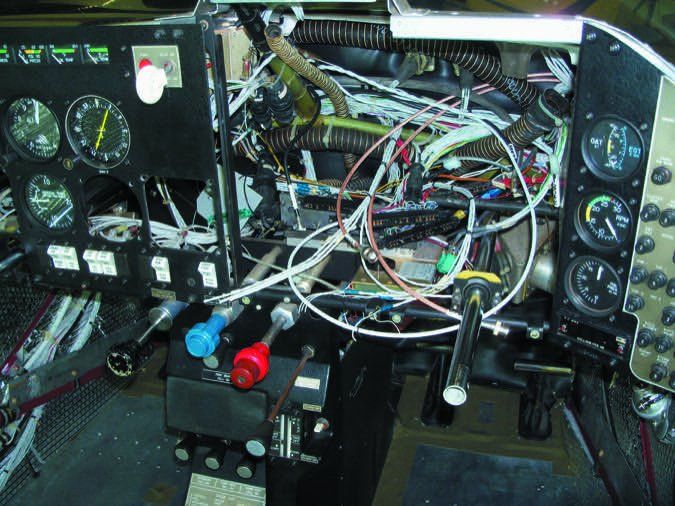There’s a lot of emphasis on airframe corrosion, yet owners and technicians rarely consider the corrosion that plagues avionics—a system that can be more susceptible than the airframe. Big-airplane maintenance programs keep on top of it for good reasons.
Corrosion can build on components that you might not give a second thought. This includes contact pins on radio connectors, antenna RF connectors (and the hidden skin at the base of the antenna—a real disaster in the making) and components that reside under the floor, inside the wing root and inside of radios.
In this article, we’ll take a look at problem areas and what you and your shop might do to stop avionics corrosion before it begins. That might include some upgrades to the avionics cooling system and antennas.
Corrosion 101
There is more than one face to corrosion and many types can grow on avionics equipment, depending on the environment, the material and the location within the airframe. It’s worth reviewing a few common types.
The most common is surface corrosion and it results from a direct chemical attack on a metal surface. We’re talking about surfaces like mounting trays, connector backplates and the radio chassis to name a few. It’s often referred to as uniform surface corrosion and it can be difficult to spot in its early stages.

The chemical elements that make up an alloyed metal are different and thereby become anodes and cathodes. The anodes and cathodes are quite small and constantly shift from one area of the surface to another. There are telltale signs.
A dull or etched surface is usually the first indication of uniform surface corrosion. Continued attack is followed by roughness and a frosty or powdered surface. You’ve seen this before, although you might have to dig (teardown is the official word in shop talk) to find it on some avionics components.
Pitting corrosion is a severe form of concentrated cell corrosion and is localized to a specific area. Pitting corrosion can be found on thin sheets of metal such as plated printed circuit board (PCB) paths, where the attack can be so severe that perforation of the plated PCB paths can occur.
Pitting usually occurs along grain boundaries and at porous finished areas on the metal. Porous gold plating on copper contacts is a common location for pitting corrosion. The plating pores create small corrosion cells that continue to expand and deepen, forming a pit. Look at aging chrome wheels on a motorcycle or vehicle and you’ll likely see signs of pitting, especially in salty locations.
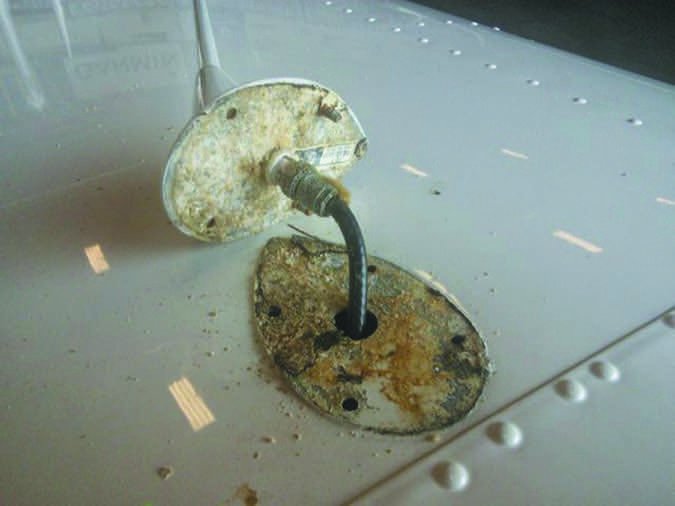
Galvanic (or bimetallic) corrosion is an electromechanical process where one metal corrodes when it comes in electrical contact with another and an electrolyte. It’s characterized by a buildup of corrosion deposits on the mating active (anoxic) surface. The rate of corrosion of a galvanic pair is a function of the difference between the reactivity of the metals. The farther apart two metals are on the galvanic series chart, the faster the active (anode) metal will corrode in the presence of the electrolyte. Get that?
Intergranular corrosion is a chemical attack that occurs at the grain boundaries of a metal. A highly magnified view of a metal surface shows individual grains. Along the grain boundaries of the primary metal are individual grains of the metallic elements that make up the alloy. These other metals have a different corrosion potential than the primary metal. Often, the grain boundaries are anoxic and tend to corrode more easily than the grains of the primary metal. When an electrolyte is present, rapid selective corrosion at the grain boundary occurs.
One type of corrosion you can easily spot around steel fasteners, as one example, is exfoliation corrosion, which is an advanced form of intergranular corrosion. This causes the metal grains to separate at the grain boundaries due to the force of corrosive expansion. This is what makes the edges of an aluminum sheet swell or lift.
These are just a few examples of corrosion that attack electrical components in the aircraft and none are good. The best defense is offense.
Look It Over
Like preventing the spread of cancer, inspection is the best way to catch corrosion in avionics before it gets out of hand. This is especially important in corrosion-prone climates—including moist hangars. Unfortunately, the avionics system in even the simplest GA aircraft isn’t easily accessed. If you’ve seen your panel torn open for an upgrade you know why. Focusing on problem areas is one place to start. More on that in a minute.
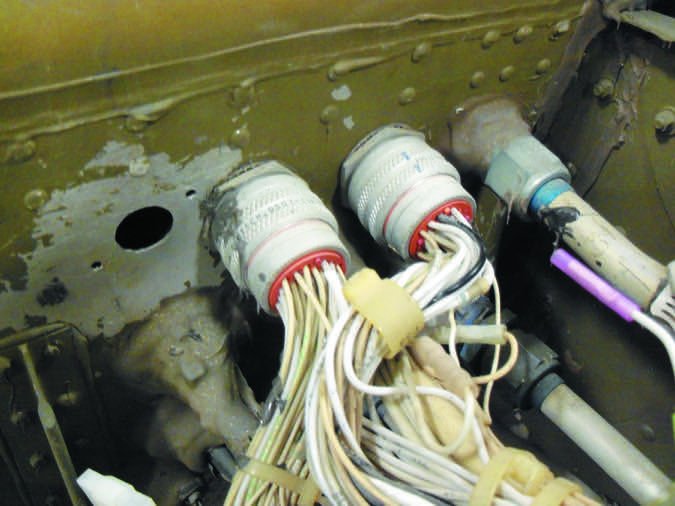
Important tools in every avionics technician’s box are magnifying glasses, inspection mirrors and flashlights. You don’t have to tear the radio stack apart to catch corrosion, although accessing the wiring and connectors is a good idea, especially if the aircraft hasn’t seen an avionics upgrades in a while.
For starters, remove the radios from their mounting racks to inspect the rear connectors and the chassis. If you’ve never done this, it’s a chore that can be simple or almost impossible, depending how tightly the radios are stacked. Many components, including Garmin and BendixKing radios, require a 3/32 hex wrench to loosen the locking mechanism, which is accessed on the bezel. Older Cessna/ARC components use a long flat-blade screwdriver.
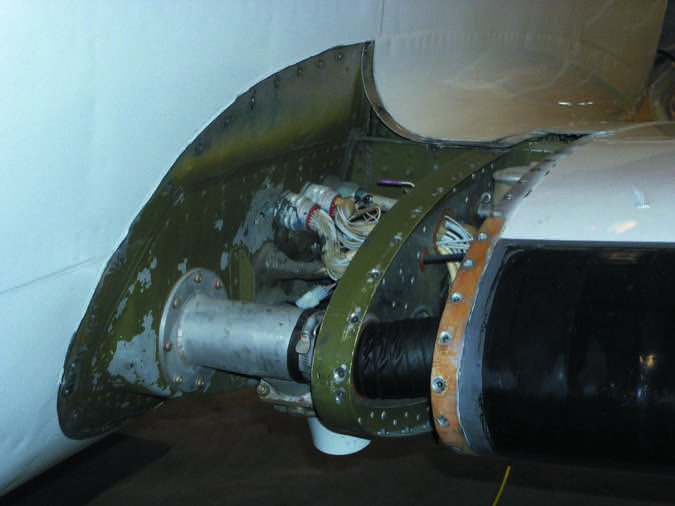
Once you have the radio in your hand, look closely at the RF antenna connections on the back, also paying close attention to the main connectors—which are generally attached to PCBs inside the chassis. Some radios have forged cooling ports that attach to cooling hoses. Shine a flashlight inside the hole and see if you can spot corrosion.
If you spot light surface oxidation on an edge connector, use a simple pencil eraser and carefully erase it clean. ACF-50—a popular aerospace anti-corrosion penetrating fog—can sparingly be used for spot treatment. Lear Chemical (ACF-50’s manufacturer) said the product is endorsed by 27 aircraft OEMs and meets Mil-spec performance criteria, plus it’s recognized by the FAA as a suitable corrosion preventive. We’ve used the product on connectors and in other areas of the airframe with positive results and you can source it online.
Use caution when reinstalling the radios because with some equipment it’s easy to bend a contact pin when you slide the radio back into the mounting rack. If there’s any doubt of your ability, grab an avionics tech for help.
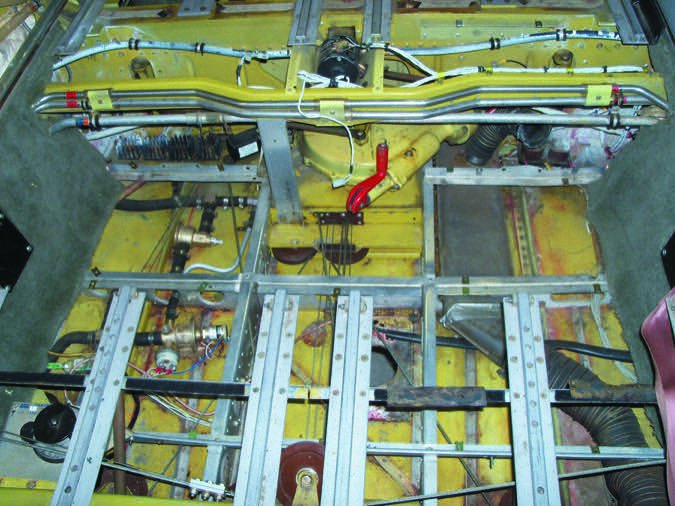
Worth mentioning is that even nonmetallic materials can be subject to corrosion. Culprits include water intrusion, fungal growth and UV light damage.
Water Cooling?
Water cooling is a tongue-in-cheek shop term we used for avionics cooling systems fed by outside ram air. Some believe it’s better than nothing because heat can be a real problem for avionics reliability, even for otherwise modern equipment. Manufacturers wisely switched to surface-mounted circuit boards and modern designs that are engineered to draw less current, but radiant heat is the killer when it comes to longevity. Even though some avionics have internal fans, it’s the buildup of standing heat that does the expensive damage in hot-weather ops. That’s why it’s important to make sure the avionics cooling system is in top shape. It’s tough to imagine, but neglected ones can be a source of corrosion.
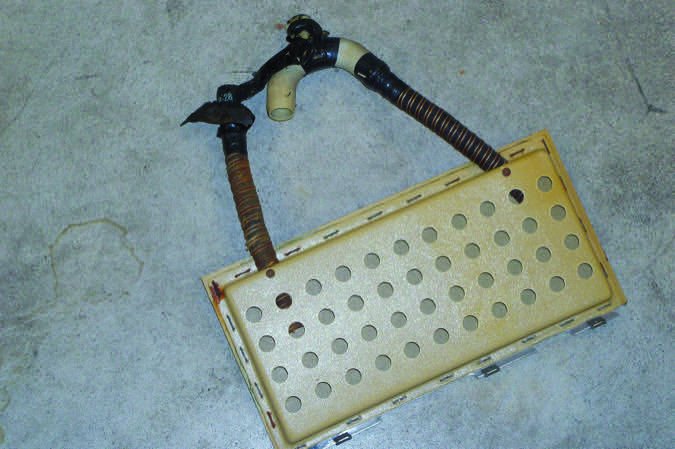
While we always advocate the use of avionics cooling systems, we’ve forever frowned on systems that source outside air. This is a common system once used on older Beechcraft and other aircraft. The design is clever, but pretty crude and itself is susceptible to corrosion.
The theory is to capture ram air through a vent in the leading edge of a wing, pipe it through scat tubing and ultimately into a plastic cooling pack/air box. Once in the box (which is mounted to the side of the radio stack), the ram air is dissipated through small holes in the side of the assembly.
For one thing, the box gets in the way when you need to work on the radio stack. Plus, it hardly provides enough airflow to properly move stagnant air away from the radios. But it gets worse.
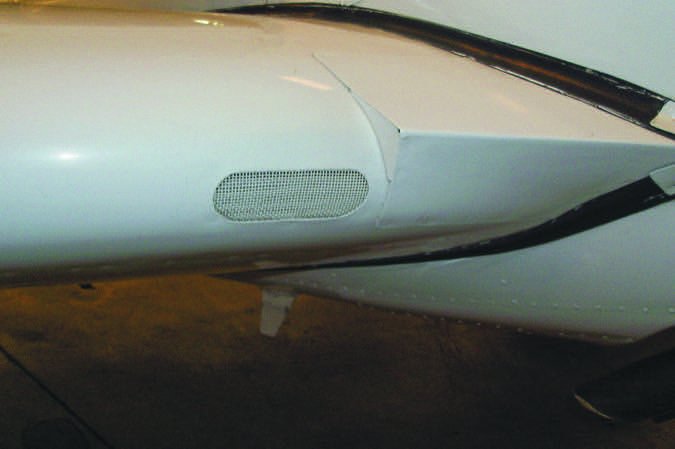
When flying through heavy rain, the potential for introducing water, small bugs and other contaminants into the system is a major concern. We’ve seen plenty of radio backplates and chassis assemblies coated with corrosion and ugly green crust due to water ingestion. Damage aside, it’s hardly effective cooling. That’s because outside ram cooling is useless when the aircraft is stationary, like when you’re sitting in a baking runup area waiting for clearance on a 90-degree day.
In an experiment we did for a previous Aviation Consumer article on cooling fans, we measured a temperature of 160 degrees F in the middle of a Piper Arrow’s radio stack. That’s the ragged edge of small component failure, rendering the ram air cooling system essentially useless.
Eliminate the moisture-induced corrosion and consider installing an avionics cooling fan. By fighting the chimney effect (this is the buildup of radiant heat caused by units at the bottom of the radio stack), avionics cooling fans move standing hot air out the front of the stack. Your avionics may even be designed to work with a fan.
Many avionics units have an air fitting on the mounting rack designed for mating with a cooling hose. One cubic foot per minute of airflow at a pressure equal to .01 inches of water does the job. The beauty of an avionics cooling fan that’s installed correctly is that it ingests dry cabin air and not moisture like ram air systems. Fans are available with single output ports or multiple ports to cool nearly all components in the stack.
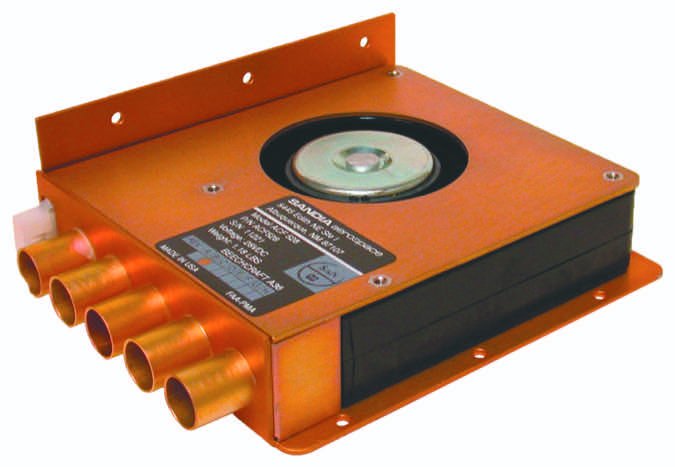
For aftermarket retrofit, Garmin markets the three-port GFC314/328 series, which are the ACF series made by Sandia Aerospace and move 25 cubic feet of air per minute. These fans use reliable and quiet brushless motors that are rated for 78,000 hours of continuous operation.
Many shops prefer the Sandia/Garmin models because they are FAA and PMA approved, eliminating the need for a silly field approval. Sandia also makes a large-capacity five-port model. We’ll look at the avionics cooling fan market in an upcoming issue of Aviation Consumer.
Antennas and Other Problem Areas
One common problem is antenna systems and the way they’re mounted to the aircraft skin. Antennas coated with fiberglass can crack around the base area and also around the screw mounting holes, which can collect water. We’ve seen some awful antenna installations done with shortcuts and poor prep work that invite corrosion down the road.
Along with manufacturer instructions, AC 43.13-2B has specific guidance for antenna work, but adherence to the advisory circular and instructions can vary by installer. A doubler plate strengthens the structure around the antenna so when the antenna vibrates in flight, it doesn’t cause damage to the skin. That same vibration is also a setup for corrosion to form.
Fretting corrosion occurs when there is slight relative movement between two materials when an electrolyte is present. Fret corrosion is typical of close-fitting, highly loaded structures—like the antenna base and the aircraft skin.
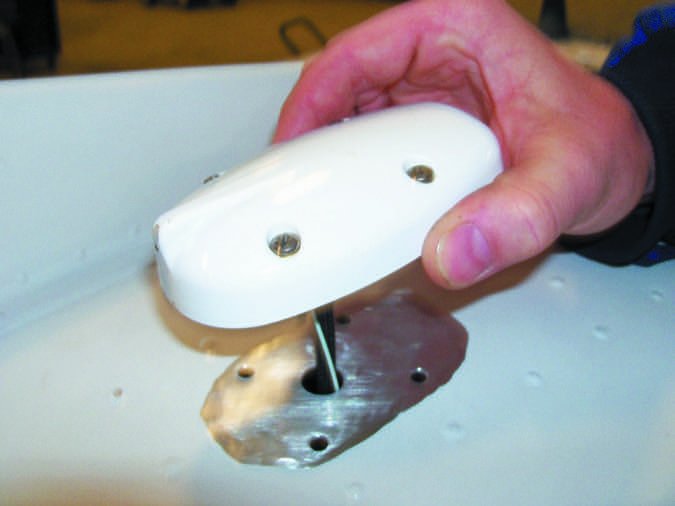
While you probably won’t easily spot corrosion that forms under an antenna, there are some clues. One thing you might try is moving the antenna, using caution to not stress the skin and/or crack the antenna. If there’s any give or hint of looseness you should dig deeper, which includes inspecting the doubler plate. Any evidence of weeping or discoloration from the base of the antenna to where it meets the fuselage is a sign to check further for corrosion.
If the base gasket is deteriorated or the silicone seal is compromised the antenna should be removed, any corrosion treated and the antenna replaced. Chances are if there’s sizable corrosion, the antenna has seen better days. We’ve seen installations where the antenna wasn’t even sealed. It’s almost a definite chance for eventual corrosion due to water intrusion around the base. Build enough corrosion and you might pay for an expensive skin repair.
Some areas of the aircraft (especially the tail) are essentially in a constant bath of moisture and dirt, which promotes corrosion. You might not give it a second look during preflight inspections (plus, you’ll need a ladder to access it), but VOR antennas have splitters and baluns that are often mounted in the tail, poorly protected by fairings. If you’ve ever chased a VOR reception problem, the culprit was likely corrosion built up on the antenna system. Corrosion can reduce receiver performance or cause intermittent reception as the corrosion worsens.
In many cases, the only way you’ll be able to properly inspect the system is to remove inspection plates and tail fairings and look for signs of moisture intrusion and resulting corrosion.
Other problem areas include RF antenna connectors and also grounding straps, which are placed around the airframe. Grounding straps electrically join control surfaces to the fuselage. Corrosion can contribute to decreased radio performance and RFI, or radio frequency interference. Coaxial cable connectors are also subject to corrosion and we think they’re worth replacing when installing new antennas. After all, they’re right in the technician’s hands, which is the best time to change them.
Conclusion
These days, avionics manufacturers consider corrosion when designing components, using sealed connectors when appropropriate. More than one shop told us it’s seeing more avionics corrosion when it opens up panels for major retrofits. That makes sense because these days more aircraft sit for long periods of time. Plus, the fleet is getting older and with age comes corrosion, especially in salt-prone climates.
Avionics corrosion control isn’t difficult when caught early. That means proactive replacement of antennas and connectors, upgrading the avionics cooling system and storing the aircraft in dry locations.

